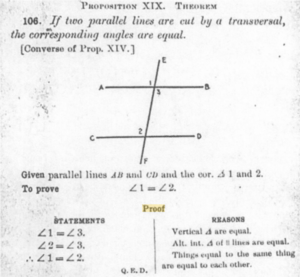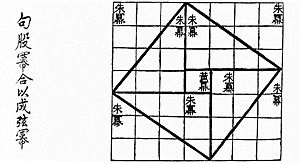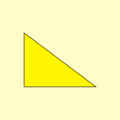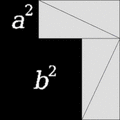Mathematical proof facts for kids
A mathematical proof is a special way to show that a math idea or theorem is always true. It's like building a strong argument to convince everyone that something works in every single case, not just a few times.
There are different methods mathematicians use to prove their ideas.
Contents
What is a Mathematical Proof?
A math proof uses logic and facts to show that a statement is true. It's not enough to just see a pattern or try a few examples. A real proof must show it works for all possible situations. Think of it as a step-by-step argument where each step is clearly correct.
Proof by Induction: Step-by-Step Logic
One common way to prove things, especially for statements about all natural numbers (like 1, 2, 3, and so on), is called proof by induction. It's like a chain reaction. If you can show the first domino falls, and that every domino falling makes the next one fall, then all dominoes will fall!
Here are the main steps for a proof by induction:
- Step 1: State the Plan.
* First, you clearly say that you will use induction. You also say which variable (like 'n') you'll be using for the induction.
- Step 2: Prove the First Case.
* You show that the statement is true for the very first number, usually n=1 (or sometimes n=0, depending on the problem). This is like pushing the first domino.
- Step 3: Assume it's True for 'n'.
* You pretend for a moment that the statement is true for some general number, let's call it n0. This is called the induction step. You assume that if a domino falls, the next one is set up to fall too.
- Step 4: Show it's True for 'n+1'.
* Now, using your assumption from Step 3, you must prove that the statement is also true for the next number, n0+1. This is the crucial part: showing that if one domino falls, it definitely knocks over the next one.
Once you've done these steps, you've proven the statement for all natural numbers. Why? Because it's true for 1 (Step 2). Since it's true for 1, it must be true for 2 (from Step 4). Since it's true for 2, it must be true for 3, and so on, forever!
Example of Induction in Action
Let's think about a simple idea: the sum of the first n numbers. We want to prove that 2 times (1 + 2 + 3 + ... + n) is equal to n times (n + 1).
- Step 1: We'll use induction on n.
- Step 2: Let's check for n=1.
* 2 times (1) = 2. * 1 times (1 + 1) = 1 times (2) = 2. * Since 2 = 2, it's true for n=1.
- Step 3: Assume it's true for some number n0.
* So, we assume that 2 times (1 + 2 + ... + n0) = n0(n0 + 1).
- Step 4: Show it's true for n0+1.
* We need to show that 2 times (1 + 2 + ... + n0 + (n0+1)) = (n0+1)(n0+1 + 1). * We know from Step 3 that 2 times (1 + 2 + ... + n0) is n0(n0 + 1). * So, 2 times (1 + 2 + ... + n0 + (n0+1)) * = 2(n0+1) + 2(1 + 2 + ... + n0) * = 2(n0+1) + n0(n0 + 1) (using our assumption from Step 3) * = (n0+1) (2 + n0) (we factored out (n0+1)) * = (n0+1) (n0 + 2) * This is exactly what we wanted to show for (n0+1)(n0+1 + 1)!
So, by induction, the statement is true for all natural numbers.
Proof by Contradiction: Showing the Opposite is Impossible
Proof by contradiction is another powerful way to prove a mathematical idea. In this method, you start by assuming that the statement you want to prove is actually false. Then, you follow the logic from that assumption. If you reach a point where your logic leads to something impossible or silly (a contradiction), then your original assumption (that the statement was false) must have been wrong. This means the statement must be true!
When mathematicians use this method, they often write "BWOC" at the start, which stands for "By Way Of Contradiction." If they find a contradiction during the proof, they might put a special symbol (like an X) next to that line.
Other Pages
Images for kids
See also
 In Spanish: Demostración en matemática para niños
In Spanish: Demostración en matemática para niños






